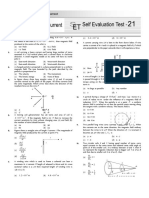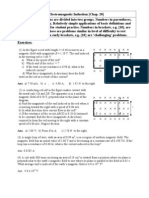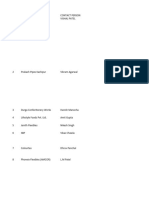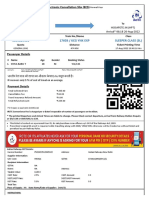Chapter
MOVING CHARGES
4 & MAGNETISM
Exam–1. A straight wire of mass 200 g and length 1.5 m carries a current of 2 A. It is suspended in mid-
air by a uniform horizontal magnetic field B (Figure). What is the magnitude of the magnetic
field?
Solution: We find that there is an upward force F, of magnitude IlB,. For mid-air suspension, this must be
balanced by the force due to gravity:
m g = I lB
mg 0.2 9.8
B= = = 0.65T
I 2 1.5
Note that it would have been sufficient to specify m/l, the mass per unit length of the wire. The
earth’s magnetic field is approximately 4 × 10–5 T and we have ignored it.
Exam–2. If the magnetic field is parallel to the positive y-axis and the charged particle is moving along the
positive x-axis (Figure), which way would the Lorentz force be for (a) an electron (negative
charge), (b) a proton (positive charge).
Solution: The velocity v of particle is along the x-axis, while B, the magnetic field is along the y-axis, so v
× B is along the z-axis (screw rule or right-hand thumb rule). So, (a) for electron it will be along
–z axis. (b) for a positive charge (proton) the force is along +z axis.
Exam–4 An element = x ˆi is placed at the origin and carries a large current I = 10 A (Figure). What
is the magnetic field on the y-axis at a distance of 0.5 m. Δx = 1 cm.
Page 1
� 0 Id sin
Solution: dB = [using Eq. (4.7)]
4 r2
0 Tm
dl x = x = 10–2 m, I = 10 A, r = 0.5 m = y, = 10 −7
4 A
θ = 90° ; sin θ = 1
10−7 10 10−2
dB = −2
= 4 10−8 T
25 10
The direction of the field is in the +z-direction. This is so since,
( )
d r = xiˆ y ˆj = yx ˆi ˆj = yxkˆ
We remind you of the following cyclic property of cross-products,
ˆi ˆj = k;
ˆ ˆj kˆ = ˆi; kˆ ˆi = ˆj
Note that the field is small in magnitude.
Exam–5. A straight wire carrying a current of 12 A is bent into a semi-circular arc of radius 2.0 cm as
shown in Figure (a). Consider the magnetic field B at the centre of the arc. (a) What is the
magnetic field due to the straight segments? (b) In what way the contribution to B from the
semicircle differs from that of a circular loop and in what way does it resemble? (c) Would your
answer be different if the wire were bent into a semi-circular arc of the same radius but in the
opposite way as shown in Figure (b)?
Solution:
(a) dl and r for each element of the straight segments are parallel.
Therefore, dl × r = 0. Straight segments do not contribute to |B|.
(b) For all segments of the semicircular arc, dl × r are all parallel to each other (into the plane of the
paper). All such contributions add up in magnitude. Hence direction of B for a semicircular arc
is given by the right-hand rule and magnitude is half that of a circular loop.
Thus B is 1.9 × 10–4 T normal to the plane of the paper going into it.
(c) Same magnitude of B but opposite in direction to that in (b).
Exam–6 Consider a tightly wound 100 turn coil of radius 10 cm, carrying a current of 1 A. What is the
magnitude of the magnetic field at the centre of the coil?
Solution: Since the coil is tightly wound, we may take each circular element to have the same radius R =
10 cm = 0.1 m. The number of turns N = 100. The magnitude of the magnetic field is,
Page 2
� 0 NI 410−7 102 1
B= = −1
= 2 10−4 = 6.28 10−4 T
2R 2 10
Exam–7 Figure shows a long straight wire of a circular cross-section (radius a) carrying steady current I.
The current I is uniformly distributed across this cross-section. Calculate the magnetic field in
the region r < a and r > a.
Solution: (a) Consider the case r > a. The Amperian loop, labelled 2, is a circle concentric with the
cross-section. For this loop,
L=2πr
Ie = Current enclosed by the loop = I
The result is the familiar expression for a long straight wire
B (2π r) = μ0I
I
B= 0
2 r
1
B (r a)
r
Now the current enclosed Ie is not I, but is less than this value.
Since the current distribution is uniform, the current enclosed is,
r 2 Ir 2
Ie = I 2 = 2
a a
Ir 2
Using Ampere’s law, B ( 2r ) = 0
a2
I
B = 0 2 r
2a
B ∝ r (r < a)
Figure shows a plot of the magnitude of B with distance r from the centre of the wire. The
direction of the field is tangential to the respective circular loop (1 or 2) and given by the right-
hand rule described earlier in this section.
This example possesses the required symmetry so that Ampere’s law can be applied readily.
Page 3
�Exam–8 A solenoid of length 0.5 m has a radius of 1 cm and is made up of 500 turns. It carries a current
of 5 A. What is the magnitude of the magnetic field inside the solenoid?
500
Solution: The number of turns per unit length is, n = = 1000 turns/m
0.5
The length l = 0.5 m and radius r = 0.01 m. Thus, l/a = 50 i.e., l >> a.
Hence, we can use the long solenoid formula, namely, Eq. (4.20)
B = μ0n I
= 4π × 10–7 × 103 × 5
= 6.28 × 10–3 T
Exam–9. The horizontal component of the earth’s magnetic field at a certain place is 3.0 ×10–5 T and the
direction of the field is from the geographic south to the geographic north. A very long straight
conductor is carrying a steady current of 1A. What is the force per unit length on it when it is
placed on a horizontal table and the direction of the current is (a) east to west; (b) south to north?
Solution: F = Il × B
F = IlB sinθ
The force per unit length is
f = F/l = I B sinθ
(a) When the current is flowing from east to west,
θ = 90°
Hence,
f=IB
= 1 × 3 × 10–5 = 3 × 10–5 N m–1
This is larger than the value 2×10–7 Nm–1 quoted in the definition of the ampere. Hence it is
important to eliminate the effect of the earth’s magnetic field and other stray fields while
standardising the ampere.
The direction of the force is downwards. This direction may be obtained by the directional
property of cross product of vectors.
(b) When the current is flowing from south to north,
θ = 0°
f=0
Hence there is no force on the conductor.
Exam–10 A 100 turn closely wound circular coil of radius 10 cm carries a current of 3.2 A. (a) What is the
field at the centre of the coil? (b) What is the magnetic moment of this coil?
The coil is placed in a vertical plane and is free to rotate about a horizontal axis which coincides
with its diameter. A uniform magnetic field of 2T in the horizontal direction exists such that
initially the axis of the coil is in the direction of the field. The coil rotates through an angle of
90° under the influence of the magnetic field. (c) What are the magnitudes of the torques on the
coil in the initial and final position? (d) What is the angular speed acquired by the coil when it
has rotated by 90°? The moment of inertia of the coil is 0.1 kg m2.
Solution: (a) From Eq. (4.12)
NI
B= 0
2R
Here, N = 100; I = 3.2 A, and R = 0.1 m. Hence,
4 10−7 3.2 4 10−5 10
B= = (using π × 3.2 = 10)
2 10−1 2 10 −1
= 2 × 10–3 T
Page 4
� The direction is given by the right-hand thumb rule.
(b) The magnetic moment is given by Eq. (4.24),
m = N I A = N I π r2 = 100 × 3.2 × 3.14 × 10–2 = 10 A m2
The direction is once again given by the right-hand thumb rule.
(c) τ=m×B [from Eq. (4.23)]
= m B sin θ
Initially, θ = 0. Thus, initial torque τi = 0. Finally, θ = π/2 (or 90º).
Thus, final torque τf = m B = 10 × 2 = 20 N m.
(d) From Newton’s second law,
d
I = mB sin
dt
where I is the moment of inertia of the coil. From chain rule,
d d d d
= =
dt d dt d
Using this,
I ω dω = m B sinθ dθ
Integrating from θ = 0 to = ,
2
f 2
I d = mB sin d
0 0
2 2
I f = − mB cos = mB
2 0
1 1
2mB 2 2 20 2
f = = −1
= 20s −1
I 10
Exam–11
(a) A current-carrying circular loop lies on a smooth horizontal plane. Can a uniform magnetic field
be set up in such a manner that the loop turns around itself (i.e., turns about the vertical axis).
(b) A current-carrying circular loop is located in a uniform external magnetic field. If the loop is
free to turn, what is its orientation of stable equilibrium? Show that in this orientation, the flux of
the total field (external field + field produced by the loop) is maximum.
(c) A loop of irregular shape carrying current is located in an external magnetic field. If the wire is
flexible, why does it change to a circular shape?
Solution:
(a) No, because that would require τ to be in the vertical direction. But τ = I A × B, and since A of
the horizontal loop is in the vertical direction, τ would be in the plane of the loop for any B.
(b) Orientation of stable equilibrium is one where the area vector A of the loop is in the direction of
external magnetic field. In this orientation, the magnetic field produced by the loop is in the
same direction as external field, both normal to the plane of the loop, thus giving rise to
maximum flux of the total field.
(c) It assumes circular shape with its plane normal to the field to maximise flux, since for a given
perimeter, a circle encloses greater area than any other shape.
Exam–12 In the circuit (Figure.) the current is to be measured. What is the value of the current if the
ammeter shown (a) is a galvanometer with a resistance RG = 60.00 Ω; (b) is a galvanometer
Page 5
� described in (a) but converted to an ammeter by a shunt resistance rs = 0.02 Ω; (c) is an ideal
ammeter with zero resistance?
Solution:
(a) Total resistance in the circuit is,
RG + 3 = 63 . Hence, I = 3/63 = 0.048 A.
(b) Resistance of the galvanometer converted to an ammeter is,
R G rs 60 + 0.02
= 0.02
R G + rs ( 60 + 0.02 )
Total resistance in the circuit is,
3
0.02 + 3 = 3.02 . Hence, I = = 0.99A .
3.02
(c) For the ideal ammeter with zero resistance,
3
I = = 1.00A
3
EXERCISES
1. A circular coil of wire consisting of 100 turns, each of radius 8.0 cm carries a current of 0.40 A. What
is the magnitude of the magnetic field B at the centre of the coil?
2. A long straight wire carries a current of 35 A. What is the magnitude of the field B at a point 20 cm
from the wire?
3. A long straight wire in the horizontal plane carries a current of 50 A in north to south direction. Give
the magnitude and direction of B at a point 2.5 m east of the wire.
4. A horizontal overhead power line carries a current of 90 A in east to west direction. What is the
magnitude and direction of the magnetic field due to the current 1.5 m below the line?
5. What is the magnitude of magnetic force per unit length on a wire carrying a current of 8 A and
making an angle of 30º with the direction of a uniform magnetic field of 0.15 T?
6. A 3.0 cm wire carrying a current of 10 A is placed inside a solenoid perpendicular to its axis. The
magnetic field inside the solenoid is given to be 0.27 T. What is the magnetic force on the wire?
7. Two long and parallel straight wires A and B carrying currents of 8.0 A and 5.0 A in the same
direction are separated by a distance of 4.0 cm. Estimate the force on a 10 cm section of wire A.
8. A closely wound solenoid 80 cm long has 5 layers of windings of 400 turns each. The diameter of the
solenoid is 1.8 cm. If the current carried is 8.0 A, estimate the magnitude of B inside the solenoid near
its centre.
9. A square coil of side 10 cm consists of 20 turns and carries a current of 12 A. The coil is suspended
vertically and the normal to the plane of the coil makes an angle of 30º with the direction of a uniform
horizontal magnetic field of magnitude 0.80 T. What is the magnitude of torque experienced by the
coil?
10. Two moving coil meters, M1 and M2 have the following particulars:
R1 = 10 Ω, N1 = 30,
A1 = 3.6 × 10–3 m2, B1 = 0.25 T
R2 = 14 Ω, N2 = 42,
Page 6
� A2 = 1.8 × 10–3 m2, B2 = 0.50 T
(The spring constants are identical for the two meters).
Determine the ratio of (a) current sensitivity and (b) voltage sensitivity of M2 and M1.
11. In a chamber, a uniform magnetic field of 6.5 G (1 G = 10–4 T) is maintained. An electron is shot into
the field with a speed of 4.8 × 106 m s–1 normal to the field. Explain why the path of the electron is a
circle. Determine the radius of the circular orbit.
(e = 1.5 × 10–19 C, me = 9.1×10–31 kg)
12. In Exercise 11 obtain the frequency of revolution of the electron in its circular orbit. Does the answer
depend on the speed of the electron? Explain.
13. (a) A circular coil of 30 turns and radius 8.0 cm carrying a current of 6.0 A is suspended vertically in a
uniform horizontal magnetic field of magnitude 1.0 T. The field lines make an angle of 60° with
the normal of the coil. Calculate the magnitude of the counter torque that must be applied to
prevent the coil from turning.
(b) Would your answer change, if the circular coil in (a) were replaced by a planar coil of some
irregular shape that encloses the same area? (All other particulars are also unaltered.)
Answer Key
–4 –4
1. π × 10 T ≃ 3.1 × 10 T
2. 3.5 × 10–5 T
3. 4 × 10–6 T, vertical up
4. 1.2 × 10–5 T, towards south
5. 0.6 N m–1
6. 8.1 × 10–2 N; direction of force given by Fleming’s left-hand rule
7. 2 × 10–5 N; attractive force normal to A towards B
8. 8π × 10–3 T ≃ 2.5 × 10–2 T
9. 0.96 N m
10. (a) 1.4, (b) 1
11. 4.2 cm
12. 18 MHz
13. (a) 3.1 Nm, (b) No, the answer is unchanged because the formula τ = N I A × B is true for a planar
loop of any shape.
Page 7





















































































